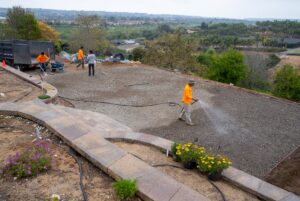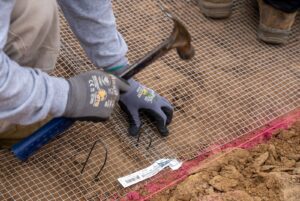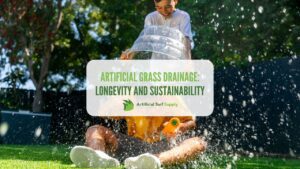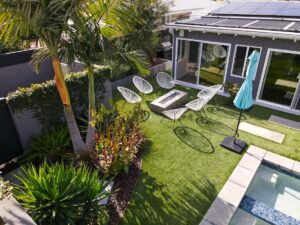At Artificial Turf Supply, we’re not just about providing top-of-the-line synthetic turf solutions; we’re committed to offering comprehensive insights and guidance to ensure our customers make the most of their investment. In this blog post, we delve into the crucial topic of artificial grass drainage, shedding light on why it matters, the different drainage systems available, and installation tips for optimal performance. Let’s explore how proper artificial grass drainage can enhance the longevity and sustainability of your artificial turf lawn.
Why Drainage Matters for Artificial Grass
Artificial grass requires effective drainage systems to maintain its pristine appearance and structural integrity. Without proper drainage, water accumulation can lead to a host of issues including mold, mildew, and degradation of the turf material.
-
- Prevention of water accumulation: Effective artificial grass drainage is essential to prevent water from accumulating on the surface of your lawn. Without proper drainage, stagnant water can create a breeding ground for mold and mildew, compromising the cleanliness and health of your lawn.
- Preservation of longevity and appearance: Proper drainage plays a crucial role in preserving the longevity and appearance of artificial grass. By allowing excess water to drain efficiently, drainage systems help prevent the breakdown of turf material caused by water saturation. This ensures that your artificial lawn maintains its lush, vibrant appearance for years to come, enhancing the overall aesthetic appeal of your outdoor space.
Types of Artificial Grass Drainage Systems
-
- Permeable backing: Artificial turf equipped with a permeable backing is designed to allow water to drain through to the ground beneath. This innovative feature facilitates efficient drainage, preventing water from accumulating on the surface of the turf and minimizing the risk of mold, mildew, and turf degradation.
- Drainage layer installation: Another effective artificial grass drainage solution involves the installation of a drainage layer beneath the artificial turf. This layer typically consists of crushed rock or gravel, strategically positioned to
 facilitate the flow of water away from the turf surface. By creating a permeable barrier between the turf and the underlying soil, this drainage layer helps prevent water pooling and ensures proper drainage throughout the lawn.
facilitate the flow of water away from the turf surface. By creating a permeable barrier between the turf and the underlying soil, this drainage layer helps prevent water pooling and ensures proper drainage throughout the lawn. - Perforated pipes: Perforated pipes can be installed beneath the turf to facilitate direct drainage of excess water away from the surface. This option is particularly useful in areas with high water flow or where traditional drainage methods may be impractical.
- French drains: French drains consist of a perforated pipe surrounded by gravel or rock, buried beneath the turf to channel water away from the surface. This type of drainage system is effective in redirecting water flow and preventing water accumulation in specific areas of the lawn.
- Subsurface drainage systems: Subsurface drainage systems involve the installation of underground pipes or channels to collect and divert excess water away from the turf surface. These systems can be customized to accommodate varying soil conditions and drainage requirements, providing comprehensive water management solutions for artificial grass installations.
By considering these different artificial grass drainage options, homeowners can choose the most suitable solution for their artificial grass installation, ensuring optimal drainage performance and long-term durability of their lawn.
Installation Tips for Optimal Drainage
Proper drainage is vital during the installation of artificial grass to ensure the health and longevity of your lawn. To optimize drainage performance, consider the following key tips.
Assessing the Need for Artificial Grass Drainage
 Start by assessing the specific drainage needs of your location and climate. Factors such as soil type, rainfall patterns, and existing drainage infrastructure should be taken into account. In areas prone to heavy rainfall or poor soil drainage, it’s essential to implement robust drainage solutions to prevent water accumulation and potential damage to the turf. By addressing drainage needs early in the installation process, you can create a resilient and long-lasting artificial grass lawn.
Start by assessing the specific drainage needs of your location and climate. Factors such as soil type, rainfall patterns, and existing drainage infrastructure should be taken into account. In areas prone to heavy rainfall or poor soil drainage, it’s essential to implement robust drainage solutions to prevent water accumulation and potential damage to the turf. By addressing drainage needs early in the installation process, you can create a resilient and long-lasting artificial grass lawn.
Best Practices for Installing Drainage Solutions
Incorporating a gentle slope into the turf installation is key to facilitating efficient water runoff. Aim for a recommended slope of 1-2% to promote optimal drainage performance, allowing water to flow freely away from the surface and preventing puddling.
To further enhance drainage effectiveness, it’s important to properly secure edging and borders around the perimeter of the artificial grass installation. This prevents water from seeping under the turf, maintaining the integrity of the drainage system and preventing water accumulation along the edges of the lawn. By carefully selecting the right drainage system, designing a proper slope, and securing edging and borders, you can ensure that your artificial grass installation achieves optimal drainage performance, promoting its longevity and aesthetic appeal. Learn more about ground preparation: artificial grass ground preparation.
Maintenance Tips for Long-Term Drainage Effectiveness
Cleaning and flushing the artificial grass drainage system as needed will help remove buildup of sediment or organic matter, ensuring unobstructed water flow. If you notice any signs of drainage issues such as water pooling or slow runoff, it’s important to address them promptly. This prevents further damage to the turf and underlying soil.
By following these installation tips and maintenance practices, you can ensure optimal drainage performance for your artificial grass lawn, promoting its longevity and aesthetic appeal for years to come. Learn more: How to clean artificial grass.
The Environmental Impact of Artificial Grass Drainage
In recent years, environmental sustainability has become a paramount concern for homeowners and landscape professionals alike. Artificial turf offers numerous environmental benefits compared to traditional grass lawns, and efficient drainage systems play a crucial role in maximizing these benefits.
Sustainability Aspect of Efficient Drainage Systems
Efficient drainage systems in artificial turf installations contribute to environmental sustainability in several ways:
-
- Water conservation: By preventing water accumulation and facilitating efficient runoff, drainage systems help conserve water resources. Unlike natural grass lawns that require regular watering, artificial turf significantly reduces water consumption, making it an eco-friendly landscaping option.
- Minimized chemical usage: Proper drainage reduces the need for chemical treatments such as pesticides and fertilizers, which can leach into soil and waterways, harming ecosystems. Artificial turf eliminates the need for these harmful chemicals, promoting a healthier and more sustainable environment.
- Reduced soil erosion: Effective drainage helps prevent soil erosion, which can occur due to water runoff and poor drainage practices. By stabilizing the soil and minimizing erosion, artificial turf installations contribute to soil conservation and ecosystem preservation.
Addressing Concerns About Water Runoff
While the environmental benefits of artificial grass are evident, concerns about water runoff and its potential impact on the environment remain. However, modern drainage solutions are specifically designed to mitigate these concerns:
-
- Permeable surfaces: Many artificial turf products feature permeable backing that allows water to drain through to the underlying soil. This prevents water from pooling on the surface and reduces the risk of runoff.
- Stormwater management: Advanced drainage systems incorporate features such as underground drainage pipes and channels to manage stormwater effectively. These systems collect and divert excess water away from the surface, minimizing the risk of runoff and soil erosion.
- Environmental certification: Look for artificial turf products that are certified by recognized environmental organizations, such as the Environmental Protection Agency (EPA) or the International Organization for Standardization (ISO). These certifications ensure that the turf meets stringent environmental standards and is designed to minimize environmental impact.
By implementing efficient artificial grass drainage systems and choosing environmentally sustainable artificial turf products, homeowners can enjoy the aesthetic and functional benefits of artificial grass while minimizing their environmental footprint. At Artificial Turf Supply, we are committed to providing eco-friendly landscaping solutions that promote sustainability and environmental responsibility.
Want to know the sustainability of artificial grass? Learn more: Artificial Grass vs Real Grass.
Investing in Longevity and Sustainability
The importance of proper drainage in artificial grass installations cannot be overstated. Effective drainage systems not only prevent water accumulation and potential damage but also contribute to the overall sustainability of your landscape.
By investing in a quality artificial grass drainage system, you’re not just enhancing its aesthetic appeal and durability; you’re also embracing environmental responsibility. With reduced water consumption, minimized chemical usage, and improved stormwater management, artificial turf offers a sustainable alternative to traditional grass lawns.
We encourage you to consider the long-term benefits of investing in a proper drainage system. From aesthetic enhancement to low maintenance and environmental stewardship, a well-designed drainage solution ensures that your artificial turf remains pristine, functional, and eco-friendly for years to come.
At Artificial Turf Supply, we’re dedicated to providing high-quality synthetic turf products and expert guidance to help you create a sustainable and beautiful landscape. Contact us today to learn more about our artificial grass solutions and take the first step towards a greener, more sustainable future.
Ready to transform your lawn? Get a free quote!




